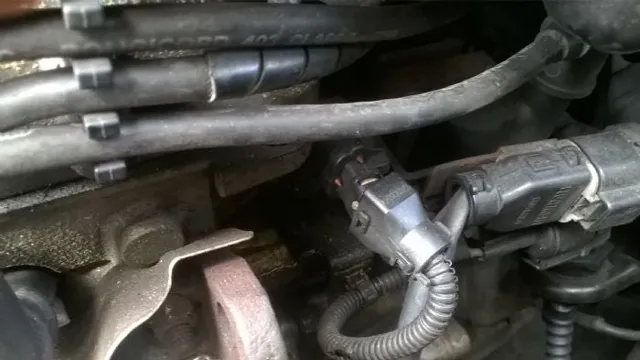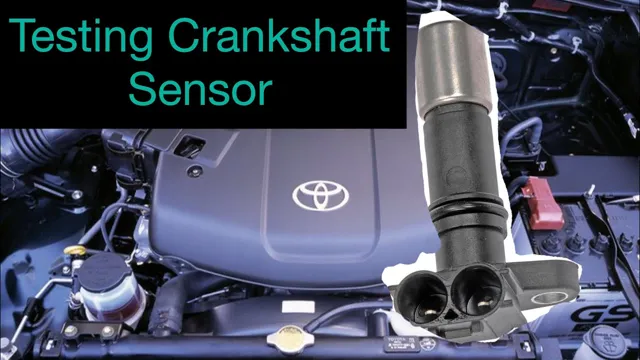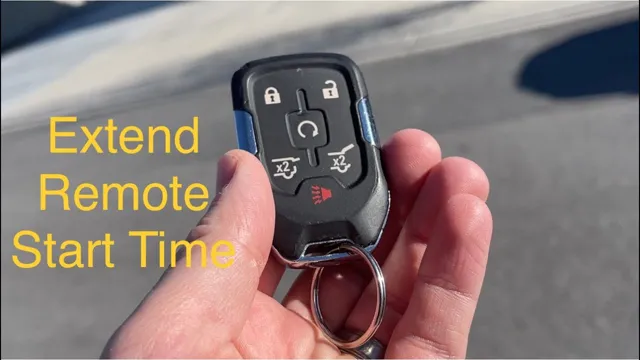How to Easily Troubleshoot and Fix Your Crankshaft Sensor for a Smoother Engine Performance!
If you’re experiencing issues with your car’s running, it could be due to a faulty crankshaft sensor. The crankshaft sensor is responsible for measuring the rotational speed and positioning of the crankshaft in your car’s engine. It’s an essential component that determines the engine’s firing sequence and ensures that the fuel injectors and ignition system work correctly.
In other words, it’s a crucial part of your car’s smooth running. But if your car’s check engine light has come on or you’ve noticed a decrease in performance, it could be due to a problematic crankshaft sensor. Thankfully, fixing this issue isn’t too difficult, and with the right tools and knowledge, you can do it yourself.
In this comprehensive guide, we’ll provide you with all the information you need to diagnose and fix your crankshaft sensor. We’ll cover everything from how to identify the problem, to the tools you need, to the step-by-step process of replacing the sensor. Whether you’re an experienced DIY mechanic or a novice, we’ll guide you through the process, making it easy and straightforward.
So if you’re ready to tackle this issue head-on, keep reading. We’re about to show you how to fix your car’s crankshaft sensor like a pro.
Understanding the Crankshaft Sensor
If you’re experiencing engine problems and suspect that your crankshaft sensor is to blame, it’s important to understand what this component does and how it works. The crankshaft sensor is responsible for detecting the position and speed of the crankshaft, which is a crucial component in the engine. The sensor sends this information to the engine control module, which uses it to adjust the timing of the engine.
This is necessary to ensure that the engine runs smoothly and efficiently. If there’s a problem with the crankshaft sensor, you may notice symptoms such as rough idling, difficulty starting the engine, or decreased fuel efficiency. To fix the crankshaft sensor, it’s best to take your vehicle to a reputable mechanic who can diagnose and repair the issue.
They may need to replace the sensor or make other repairs to your engine. With the right care and maintenance, your engine should be running smoothly and efficiently in no time.
What is the crankshaft sensor and what does it do?
The crankshaft sensor is a vital component of a car’s engine management system. This sensor serves as an indicator of the engine’s position, speed, and rotational direction by measuring the crankshaft’s rotation. It does this by sensing the position and speed of the engine’s crankshaft, which spawns from the engine block.
The sensor sends a signal to the ECU (engine control unit), which then controls critical engine functions. These functions include fuel injection timing, ignition timing, and camshaft timing. Therefore, if crankshaft sensors fail, your vehicle will not operate appropriately.
Signs of a faulty crankshaft sensor include difficulty starting the car, stalling engine, decreased gas mileage, and weak acceleration. Overall, the crankshaft sensor is of utmost importance in an engine system and must be maintained regularly to keep the engine functional.

Signs that your crankshaft sensor may be faulty
The crankshaft sensor is an essential component of your vehicle’s engine management system. It’s responsible for monitoring the rotation of the crankshaft and providing accurate information to the ECU, enabling it to adjust fuel delivery and ignition timing. Without a functioning crankshaft sensor, your engine may experience a range of issues, including rough idle, hesitation, reduced power, and even stalling.
Signs that your crankshaft sensor may be faulty include difficulty starting the engine, loss of power during acceleration, and misfiring or backfiring. If you suspect your crankshaft sensor may be causing problems with your engine, it’s important to have it checked and replaced if necessary to ensure your vehicle remains running smoothly. Don’t wait until a small issue becomes a bigger problem – address concerns with your crankshaft sensor right away to avoid costly repairs down the road.
Diagnosing the Problem
If you’re experiencing issues with your car’s acceleration and suspect that the crankshaft sensor might be the problem, there are a few steps you can take to diagnose the issue. First, check the sensor for any physical damage or signs of wear and tear. Then, using a multimeter, test the sensor’s electrical resistance and compare it to the manufacturer’s specifications.
If the resistance is too high or too low, the sensor may need to be replaced. Another possible issue could be a faulty wiring or connector, so it’s important to check those as well. In some cases, a malfunctioning sensor may not actually be the culprit, so it’s important to consult with a professional mechanic before making any repairs.
Don’t let a faulty sensor disrupt your car’s performance – with a little bit of troubleshooting and the right tools, you can get back on the road in no time.
How to check the crankshaft sensor
When checking the crankshaft sensor, it’s important to start by diagnosing the problem. Symptoms of a faulty crankshaft sensor can include stalling or hesitating engine performance, misfires, and an illuminated check engine light. One way to confirm that the issue is with the sensor is to use a scan tool to check for fault codes related to the sensor.
It’s also a good idea to inspect the sensor physically, checking for signs of damage or wear. Once you’ve identified that the problem is indeed with the crankshaft sensor, it’s time to replace it with a new one. Properly diagnosing the issue and addressing it in a timely manner can help prevent further damage to your vehicle’s engine.
Common issues with the crankshaft sensor
The crankshaft sensor plays a crucial role in the overall performance of your vehicle’s engine. However, when issues arise with this sensor, diagnosing the problem can be a bit tricky. One common problem with the crankshaft sensor is a faulty reading that causes the engine to run erratically or not at all.
This can be caused by a damaged sensor, corroded wiring, or an issue with the sensor’s connection to the engine control module. To diagnose the issue, a mechanic may use a diagnostic tool to read the sensor’s output and determine if it is sending accurate data. Another issue can be with the sensor’s location, as it can be exposed to extreme temperatures or debris that can cause it to malfunction.
In this case, relocating the sensor may solve the issue. It’s important to address any crankshaft sensor problems promptly, as they can cause further damage and lead to costly repairs. By staying aware of common issues and seeking professional help when needed, you can keep your engine running smoothly and efficiently.
Fixing the Crankshaft Sensor
If you are experiencing issues with your vehicle stalling or not starting, it could be due to a faulty crankshaft sensor. The crankshaft sensor is an important component in your vehicle’s engine management system and helps to regulate the timing and fuel injection. Fortunately, fixing a crankshaft sensor is relatively easy.
First, locate the sensor typically found near the base of the engine. Next, remove any connectors and screws holding the sensor in place, making sure to disconnect the battery beforehand. Replace the old sensor with a new one, making sure to securely fasten it in place.
Finally, reconnect any connectors and screws and start your vehicle to ensure the sensor is working properly. It’s important to note that while fixing the crankshaft sensor is an easy task, it should only be attempted by those with experience and knowledge in auto repair. If you’re unsure or uncomfortable, it’s best to seek the assistance of a professional mechanic.
Step-by-step guide to replacing the crankshaft sensor
Replacing a faulty crankshaft sensor can be a daunting task, but with the right tools, patience, and a step-by-step guide, it can be done in no time. The crankshaft sensor is responsible for monitoring the engine’s RPM (revolutions per minute) and relaying this information to the vehicle’s computer system. A malfunctioning crankshaft sensor can cause a variety of problems such as stalling, misfiring, or even preventing the car from starting altogether.
Begin by locating the sensor, typically found near the bottom of the engine block. Then, disconnect the battery, remove any necessary components to access the sensor, and disconnect the electrical connector. Using a socket or wrench, remove the bolt(s) securing the sensor in place and gently pull it out.
Replace the old sensor with the new one, making sure it is aligned correctly, and secure it with the bolt(s). Reconnect the electrical connector, reattach any components and reconnect the battery. Finally, start the engine and make sure the sensor is functioning correctly.
By following these simple steps, you can easily fix a faulty crankshaft sensor and get your vehicle running smoothly once again.
Tools and equipment needed
One of the first things you’ll need to fix a crankshaft sensor is a good set of tools. Among others, you’ll need a socket set and wrenches, pliers, a multimeter, and a jack and jack stands. Once you have all the necessary tools, the next step is to locate the sensor.
Typically, it is located near the engine block, but you may need to consult the vehicle manual to pinpoint its exact location. Once you locate the sensor, remove it by disconnecting any wires and unscrewing any bolts that hold it in place. Then, insert the new sensor, and reattach any wires and bolts.
Test the new sensor with a multimeter, and make any necessary adjustments to ensure it’s working properly. In short, fixing a crankshaft sensor is a job that requires some expertise and the right tools, but it can save you time and money in the long run.
Tips for a successful replacement
If you’re experiencing engine problems like rough idling, stalling, reduced power, or poor acceleration, your crankshaft sensor could be faulty and needs to be fixed or replaced. One of the main reasons behind these problems is a faulty sensor, so it’s crucial to address the issue as soon as possible. Replacing it can be a cumbersome process, but with some tips, you can do it successfully.
The first thing to do is to get the correct replacement sensor that matches your car’s make and model. Before installing the new sensor, clean the surrounding area of any debris and carbon buildup. It’s also advisable to use a torque wrench and follow the manufacturer’s instructions while tightening the bolts.
To ensure your sensor’s longevity, regular maintenance is essential. Regularly inspecting the sensor and making sure it’s free from dirt and physical damage is crucial. With proper care and maintenance, you can avoid any future issues and ensure that your engine runs smoothly.
Conclusion
So there you have it! Fixing a crankshaft sensor may sound daunting, but with a little bit of know-how and patience, it’s a simple task anyone can do. Just remember to unplug the battery, locate the sensor, remove any obstructions, replace the faulty part, and reassemble everything. Once you’ve completed these easy steps, your vehicle should run like a charm! And who knows, maybe you’ll impress your mechanic friends and become the designated crankshaft sensor fixer at your garage.
Happy repairing!”
FAQs
What are the symptoms of a faulty crankshaft sensor?
Symptoms of a faulty crankshaft sensor include engine misfires, stalling, hesitation, and difficulty starting the engine.
Can a faulty crankshaft sensor cause the check engine light to come on?
Yes, a faulty crankshaft sensor can trigger the check engine light to come on because it is a critical component in the engine’s operation.
How long does it take to replace a crankshaft sensor?
The time it takes to replace a crankshaft sensor varies depending on the make and model of the vehicle. It can take anywhere from 30 minutes to a few hours.
Can I drive my car with a faulty crankshaft sensor?
It is not recommended to drive your car with a faulty crankshaft sensor because it can cause serious damage to the engine and lead to safety issues on the road. It’s best to have it repaired as soon as possible.






